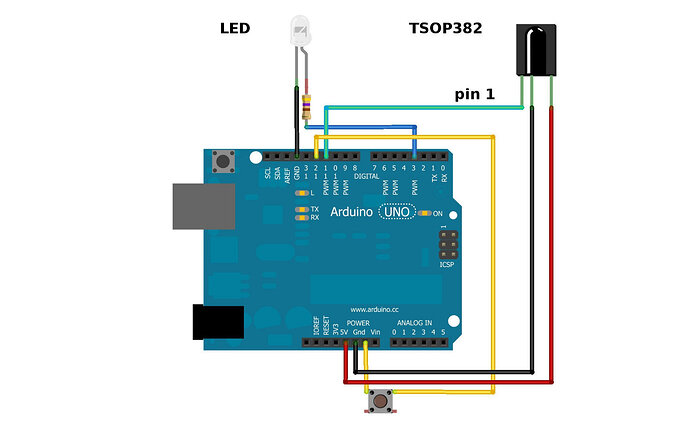Hello
Is there anyone capable of emitting an IR signal from around ten meters (like all TV remote controls) using an Arduino card?
Because having tested around fifty possibilities it seems that there is a weakness in the IR frequency modulation on this type of card and it is impossible to communicate at more than 30 cm even in boost and whatever the electronic components...
Thanks in advance !
There are some really powerful IR LEDs available.
I use Aliexpress for my supplier. Takes a while to get them.
Requires a constant current driver.
Do a Google search for "led high power ir".
Edit: Here is a link to the ones I use
https://www.aliexpress.us/item/2255800880304876.html?spm=a2g0o.order_list.order_list_main.20.38631802SpRZxI&gatewayAdapt=glo2usa
I get my drivers here
The drivers have a digital control line that allows PWM
@alexgfit
You should at least be able to do 3-4 meters
Please post a schematic / wiring diagram of how you have things connected.
Also post your code using code tags <CODE>
Which Arduino are you using?
It should be very easy to bridge several metres with an Arduino, a common IR LED with 100ohm resistor and an 38kHz 3-pin IR receiver. Show us your attempts.
Leo..
It depends on the distance. The inverse square law applies here.
If your present IR source is adequate at 10 feet, it will take 9 times the power to go 30 feet.
It's not just a good idea. It's the law.
Edit: I should mention you can increase power in a specific direction with optics.
I have been driving reliably common ir-leds rated max 100mA at 1000mA for years, never burnt one. Of course, for remote control purpose, not continuous (short pulse,duty cycle,pwm).
If you can point them precisely, you could use small half angle leds to further improve distance. Even few of them.
10m is doable.
You are probably doing something wrong.
Please post a link to the "card", examples of the code (using code tags), and a wiring diagram.
I use different types of Arduino Nano cards (every, 33 IoT).
I used IRremote library and different kind of powerful IR leds, transistors, resistances. It seems to be a frequency modulation problem from the library because as everybody said here, in fact in theory it should works, and i tried an lot of different codes too, but always the same distance problem (50cm maximum...).
Could you explain how to use and to link drivers (i didn't know this component)
thank you
No useful information posted.
The beam break device I once made used a 3-pin sensor and a 5mm IR LED.
With about 120mA peak through the LED it had no problems bridging 50metres outside in broad daylight. No optics.
Show us what you're doing wrong.
Leo..
IRRemote has been used successfully (more than 30cm) by many, many people. So why don't you post the circuit and sketch you're using, and maybe someone can help. But we aren't gifted with remote viewing.
Also, which TV you're trying to control.
Why it seems "frequency modulation problem"?
To me it seems powering problem.
If you try to power your led from gpio at 20mA, that would be more less the range I would expect.
#include <IRremote.h>
const int buttonPin = 2; // Pin for the button
const int ledPin = 13; // Pin for the LED (or infrared module)
IRsend irsend;
void setup() {
pinMode(buttonPin, INPUT);
pinMode(ledPin, OUTPUT);
}
void loop() {
if (digitalRead(buttonPin) == HIGH) {
// Button press detected
digitalWrite(ledPin, HIGH); // Turn on the LED (or infrared module)
delay(50); // Wait a short moment to avoid button bounce
// Send the infrared signal
irsend.sendNEC(0x00FF30CF, 32); // Example NEC code (replace with your own code)
digitalWrite(ledPin, LOW); // Turn off the LED (or infrared module) after sending
delay(500); // Delay between transmissions to avoid interference
}
}
If you need better range, you should power that led from 5V pin with help of transistor. Just normal BC337 is ok. I'm using very low value resistor 4.7ohm, but you could start with 20-50ohm.
Also I don't know your library (there are many named like this), but in your code there is not any line where you set frequency...
Finally I found the solution and as I thought, it is indeed a frequency modulation problem managed by Arduino. The range is effective (15 meters) in 8 bits and not in 31 bits signals.
This topic was automatically closed 180 days after the last reply. New replies are no longer allowed.
